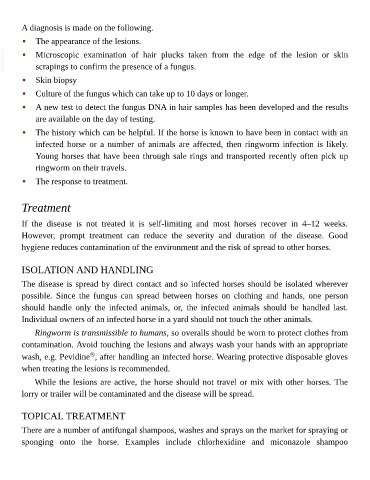Page 817 - The Veterinary Care of the Horse
P. 817
A diagnosis is made on the following.
• The appearance of the lesions.
VetBooks.ir • Microscopic examination of hair plucks taken from the edge of the lesion or skin
scrapings to confirm the presence of a fungus.
• Skin biopsy
• Culture of the fungus which can take up to 10 days or longer.
• A new test to detect the fungus DNA in hair samples has been developed and the results
are available on the day of testing.
• The history which can be helpful. If the horse is known to have been in contact with an
infected horse or a number of animals are affected, then ringworm infection is likely.
Young horses that have been through sale rings and transported recently often pick up
ringworm on their travels.
• The response to treatment.
Treatment
If the disease is not treated it is self-limiting and most horses recover in 4–12 weeks.
However, prompt treatment can reduce the severity and duration of the disease. Good
hygiene reduces contamination of the environment and the risk of spread to other horses.
ISOLATION AND HANDLING
The disease is spread by direct contact and so infected horses should be isolated wherever
possible. Since the fungus can spread between horses on clothing and hands, one person
should handle only the infected animals, or, the infected animals should be handled last.
Individual owners of an infected horse in a yard should not touch the other animals.
Ringworm is transmissible to humans, so overalls should be worn to protect clothes from
contamination. Avoid touching the lesions and always wash your hands with an appropriate
®
wash, e.g. Pevidine , after handling an infected horse. Wearing protective disposable gloves
when treating the lesions is recommended.
While the lesions are active, the horse should not travel or mix with other horses. The
lorry or trailer will be contaminated and the disease will be spread.
TOPICAL TREATMENT
There are a number of antifungal shampoos, washes and sprays on the market for spraying or
sponging onto the horse. Examples include chlorhexidine and miconazole shampoo

